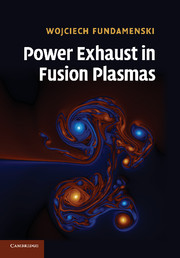Book contents
- Frontmatter
- Contents
- Preface
- 1 Introduction
- 2 Magnetized plasma physics
- 3 Magnetized plasma equilibrium
- 4 Magnetized plasma stability
- 5 Collisional transport in magnetized plasmas
- 6 Turbulent transport in magnetized plasmas
- 7 Tokamak plasma boundary and power exhaust
- 8 Outlook: power exhaust in fusion reactors
- Appendix A Maxwellian distribution
- Appendix B Curvilinear co-ordinates
- References
- Index
1 - Introduction
Published online by Cambridge University Press: 04 August 2010
- Frontmatter
- Contents
- Preface
- 1 Introduction
- 2 Magnetized plasma physics
- 3 Magnetized plasma equilibrium
- 4 Magnetized plasma stability
- 5 Collisional transport in magnetized plasmas
- 6 Turbulent transport in magnetized plasmas
- 7 Tokamak plasma boundary and power exhaust
- 8 Outlook: power exhaust in fusion reactors
- Appendix A Maxwellian distribution
- Appendix B Curvilinear co-ordinates
- References
- Index
Summary
‘Faced with something unusual our thought should not be “What next?” but “Why?”. By answering the second of these questions we can answer the first. And this, in brief, is the scientific method.’
Roger Scruton (c. 1990)By definition, all exothermal reactors, including any fusion reactor one may envisage (tokamak, stellarator, etc.), produce both energy and spent reactants, or ash. In order for the reactor to operate in steady-state, (i) fresh fuel must be added at the rate at which it is consumed, (ii) this fuel must be heated, ideally by the reactions themselves, (iii) fuel must be confined, by whatever means are available, for sufficiently long to allow the exothermic processes to continue, (iv) the energy and ash must be removed from the system at the rate at which they are created, (v) the impurities released from the reactor walls must likewise be removed at the rate at which they are produced, and (vi) the reactor itself, primarily its walls, must not be damaged by all the exhaust processes. Translating the above to a D–T burning tokamak, conditions (i)–(iii) may be labelled loosely as the ignition criteria, and conditions (iv)–(vi) as the exhaust criteria. Taken together they constitute the criteria of mutual compatibility between the burning plasma and first wall materials/components.
- Type
- Chapter
- Information
- Power Exhaust in Fusion Plasmas , pp. 1 - 15Publisher: Cambridge University PressPrint publication year: 2009

